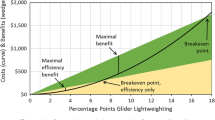Abstract
Lightweight is an effective design strategy to conserve energy in automotive vehicles. It is a big challenge to evaluate the level of lightweight for passenger cars. This paper summarizes various evaluation methods for lightweight automotive vehicles. A lightweight index [Lv for internal combustion engine vehicles (ICEVs) and Lev for battery electric vehicles (BEVs)] is proposed to assess the lightweight of passenger cars. The proposed lightweight index is composed of the nominal density, weight-to-power ratio, and fuel consumption of footprint area (in the case of ICEVs) or electricity consumption of footprint area (in the case of BEVs). The validity and universality of the proposed lightweight index are demonstrated through a statistical analysis of 7018 ICEV and 326 BEV models. The calculation procedures of the standard partial regression coefficients of statistical multiple regression and elastic coefficients are employed in the proposed method. The results show that either Lv or Lev is most sensitive to the curb mass of the vehicles. The proposed lightweight index can help guide automakers in setting reasonable weight reduction targets during new product development. In addition, the proposed lightweight index can be applied to new hybrid electric vehicles with further efforts, to facilitate the development of lightweight automotive design.


Similar content being viewed by others
Abbreviations
- BEVs:
-
Battery electric vehicles
- C-NCAP:
-
China-New Car Assessment Program
- ICEVs:
-
Internal combustion engine vehicles
- VSP:
-
Vehicle-specific power
References
Hao, H., Wang, S., Liu, Z., et al.: The impact of stepped fuel economy targets on automaker’s light-weighting strategy: the China case. Energy 94, 755–765 (2016)
China society of automotive engineers: china automotive lightweight development-strategy and path. Beijing Institute of Technology Press, Beijing (2016)
China Society of Automotive Engineers: Annual Evaluation of Technology Roadmap for Energy Saving and New Energy Vehicle 2019, pp. 63–64. China Machine Press, Beijing (2020)
Lotus Engineering Inc.: Evaluating the Structure and Crashworthiness of a 2020 Model-Year, Mass-Reduced Crossover Vehicle Using FEA Modeling. Lotus Engineering Inc, Norfolk (2012)
Lu, H.Z., Wang, Z.W., Ma, M.T., et al.: Multi-objective evaluation regulation study of automotive lightweight. Paper presented at FISITA 2014 World Automotive Congress China Society of Automotive Engineers, Beijing, 27–30 November (2012)
Li, J., Chen, Y.X., Sun, W.J., et al.: Research on lightweight evaluation method of passenger vehicles. Autom. Technol. Mater. 9, 1–5 (2014)
Lu, H.Z., Wang, Z.W., Chen, Y.L., et al.: Coupling study of fuel consumption and lightweight objective of SUV cars. Paper presented at FISITA 2014 World Automotive Congress, Maastricht, The Netherlands, 2–6 June (2014)
Xu, K., Liu, H., Deng, Z.: Multi-objective coupling vehicle mass target setting method. Int. J. Adv. Manuf. Technol. 94, 3455–3463 (2018)
Malen, D.E., Hughes, J.: Mass benchmarking using statistical methods applied to automotive closures. SAE Int. J. Mater. Manuf. 8, 853–863 (2015)
Li, D., Wang, S., Men, L.Z.: Method of assessment model of vehicle weight target. Auto Eng. 9, 21–24 (2016)
Insurance Institute for Highway Safety: How size and weight affect safety. https://www.iihs.org/topics/vehicle-size-and-weight. Accessed in 26 June 2020
Kleijnen, J.P.C., Helton, J.C.: Statistical analyses of scatterplots to identify important factors in large-scale simulations, 2: robustness of techniques. Reliab. Eng. Syst. Saf. 65(2), 187–197 (1999)
Wang, Y.A., Chen, Y.M., Han, Y.H.: Forecast of passenger and freight traffic volume based on elasticity coefficient method and grey model. Proc. Soc. Behav. Sci. 96(6), 136–147 (2013)
Song, G.H., Zhou, X.X., Lei, Y.: Delay correction model for estimating bus emissions at signalized intersections based on vehicle specific power distributions. Sci. Total Environ. 514, 108–118 (2015)
CATARC: GB 27999–2019, Fuel Consumption Evaluation Methods and Targets for Passenger Cars
U.S. Environmental Protection Agency: Joint Technical Support Document–Final Rulemaking to Establish Light-Duty Vehicle Greenhouse Gas Emission Standards and Corporate Average Fuel Economy Standards, U.S. Department of Transportation (2012)
Yu, R.J., Liu, S.H.: Research on the influence of passenger car fuel consumption standard based on footprint area. Autom. Parts 6, 81–82 (2015)
Acknowledgements
This research is funded by National Key Research and Development Program of China (Grant No. 2016YFB0101605).
Author information
Authors and Affiliations
Corresponding authors
Ethics declarations
Conflict of interest
The authors declare that they have no conflict of interest.
Rights and permissions
About this article
Cite this article
Li, J., Wang, L., Chen, Y. et al. Research and Application of Lightweight Index for Passenger Cars. Automot. Innov. 3, 270–279 (2020). https://doi.org/10.1007/s42154-020-00110-4
Received:
Accepted:
Published:
Issue Date:
DOI: https://doi.org/10.1007/s42154-020-00110-4



